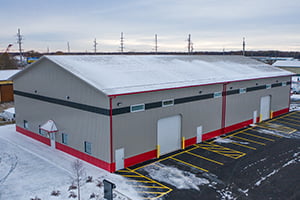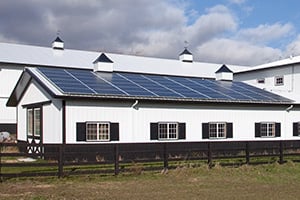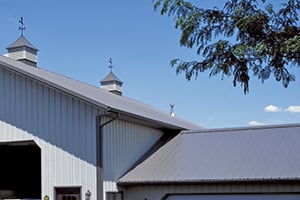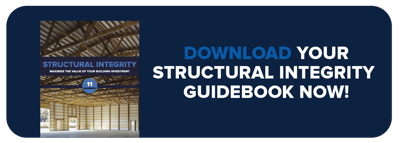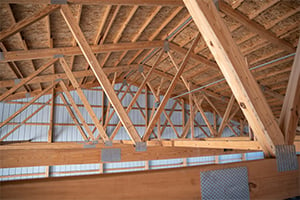Posts | Building Tips | Structural Integrity
What Pole Barn Features Affect Your Snow Load?
After working in the banking industry for 5 years after college, Courtney realized she needed a change and decided to pursue a new career path. Growing up she has always been creative and enjoyed writing, taking pictures, or painting. Now as the Marketing Content Creator for FBi Buildings, she gets to utilize her creative abilities in her everyday work. In her free time, you can find Courtney at home reading a book, partaking in any and all outdoor activities, or traveling and photographing her adventures. Courtney resides in Northwest Indiana with Lacey, her red tick coonhound.
It's Sunday, March 8th, 1998. The sun is shining, birds are chirping, and life is good. Winter has been long and dark, but in the air, there is a promise of Spring.
The weather is tolerable, so you're outside prepping your lawn and garden for the warm weather that will undoubtedly be here soon. Just when you start to get somewhere, dark clouds begin to roll in and threaten a storm. In no time, rain begins to fall, so you inevitably head inside to stay dry — dang you, crazy Midwest weather.
Fast forward to Monday morning when you wake up for work and see that there's well over a foot of snow outside. You turn the radio on to listen to what the weather man has to say.
Power lines are down. A state of emergency has been issued. The National Guard has been called out to rescue stranded motorists…Well, that escalated quickly.
After the initial shock of realizing winter is not leaving any time soon, you walk to the window to sulk. Only then do you notice a substantial amount of snow that has accumulated on the roof of your pole barn. You start to think to yourself, "Did I consider snow pile up when selecting the building design for my pole barn?"
Don't worry; we're here to inform you that there are steps you can take when selecting your pole barn design that will help eliminate snow piling up. Certain features might cause snow pile up more than others, but that doesn't mean you should avoid them altogether.
In this blog, we will discuss what features affect snow load and what you can do to defend your pole barn from structural failure.
What Is Pole Barn Snow Load?
Snow load is considered the downward force on a structure's roof by the accumulation of snow and ice. When designing a pole barn, engineers use snow loads to help estimate the overall support a building's roof needs to withstand snowfall within that building's region. For example, a post frame building built in Alaska will have a higher snow load than a post frame building built in Florida.
To figure out the roof snow load, ground snow load must be calculated. There is a standard that engineers follow every time they design the structure of a post frame building, and that is the American Society of Civil Engineers Standard (ASCE 7-10.) Snow load is obtained directly from the ASCE 7-10.
What Is The Importance of Snow Load?
If snow load is not calculated correctly in the design stage of building your pole barn, issues could arise later on down the road, such as:
- Your roof can begin to sag from the weight it endured
- A sagging roof can start to leak
- Lumber can become cracked
- The drywall on the inside and masonry on the outside can begin to crack
- Truss members, headers, rafters, columns, and purlins can bow
- Sliding doors and windows might not be able to open correctly, if at all
These issues are the reason the structural design stage is vital. It's better to consider the consequences upfront than have to deal with them later on. The more time you spend on designing means, the less time you'll spend on repairing pole barn damages.
Keep in mind though that depending on the type of pole barn you are constructing, the features you choose may vary from each pole building. Certain features on commercial buildings will not be necessary on agricultural pole barns. Certain features on residential buildings will not be necessary on equestrian pole barns.
Below are some of the features that may affect your snow load that you will want to consider when building pole barns.
Pole Barn Features That Affect Snow Load
1) Solar Panels
If you're looking to have a more energy-efficient post frame building, solar panels are a great option to help you achieve this. Solar panels are installed on the roof to convert energy from the sun (direct current electricity) into the type of energy that will power your building (alternating current electricity.)
One of the downsides to having solar panels installed on your pole barn is that they can potentially collect more snow. Build-up can occur when the snow is not given the option to slide off as quickly as if there were no interruptions on the roof. It is imperative discuss installing solar panels with your builder up front so the weight of these can be accounted for in the design. If you do not mention this and add them on later, this could be extremely dangerous to your pole barn.
2) Rooftop Mechanicals
Utilized mostly on commercial post frame structures, rooftop mechanicals include your heating and cooling systems. These systems are not lightweight by any means, so like the solar panels, they are just added weight on top of the weight of the snow. Sometimes the only choice is to have the mechanicals installed on the roof, so it's essential to keep the weight in mind when designing your post frame building.
As with solar panels, make sure to discuss installing mechanicals on the roof with your builder so the weight of them can be accounted for in the design.
3) Parapet Style Roof
A parapet is an upward extension of the wall, which forms a barrier around the perimeter of the roof. The actual roof itself is flat, so this barrier can potentially keep more snow trapped as the snow would have nowhere to go. If the snow does not melt quickly, having that weight on the roof for so long could possibly cause some severe damage.
4) Dormers
Dormers are structures, which often have a window that projects vertically above a pitched roof. Similar to how the solar panels affect snow load, these dormers could potentially hold more snow as the snow does not slide off the roof as easily. This added weight could cause damage to the dormers and the roof.
5) Extreme Changes in Roof Pitch
Have you ever driven down the road and noticed snow collected in crevices of the change in roof pitch? If not, you'll definitely notice it now since we said something about it.
The reason snow gets collected here is because of the pattern of the wind. Snow gets blown into these crevices and has nowhere to go, so the snow just accumulates and builds more weight, which could lead to damage if it doesn't melt quickly enough.
Don't let these features scare you, though. We're not saying you shouldn't select them for your pole barn. We're just here to inform you of what could happen if the design stage is not taken seriously.
How to Defend Your Pole Barn from Snow Loads
There are many ways you can defend snow load when designing your pole barn. It is crucial to find a post frame builder who has an in-house engineering team. This will be very beneficial as they can provide you with the best possible product. Not only do they factor in the snow load for you, but they take into consideration the structural integrity of your pole barn.
Structural integrity refers to a pole barn's ability to withstand anticipated structural loads without breaking. Any post frame building, regardless of size and location, must be designed to resist vertical and lateral loads safely.
When working with an in-house engineering team, they’ll make sure your building is defended from snow loads in the following ways:
1. Proper Spacing of Purlins
A purlin is a horizontal beam on a pole barn that runs the length of the roof. Purlins are a significant component as they provide ample support for the roof. The improper spacing of the purlins can affect the structural integrity making the roof more susceptible to damage.
The closer the purlins are together, the more weight they can support. In addition, the closer they're spaced together means the snow weight will be more evenly transferred to the trusses.
2. Use of Quality Lumber
You don't want a post frame builder who uses weak, low-quality lumber when building a pole barn that is meant to last for many years. Find a pole barn builder who uses high-quality materials or even uses lumber that is machine stress-rated (MSR.)
Machine stress-rated means the lumber has been tested by a machine that will examine the strength of each piece of lumber used in your post frame building. The stronger the lumber, the less susceptible to damage it is.
3. Build with Trusses Made for Snow Load
Just like purlins, trusses are imperative to structural integrity, too. Your pole barn builder will use trusses specifically designed to withstand the snow load in your area.
Trusses that are most suitable for your area will be sturdy, machine stress-rated, and have truss plates that are specifically designed to support substantial amounts of snow. It's also imperative to mention that the column strength should mimic the trusses to hinder failure at any point in the transfer of weight.
Will You Incorporate These Pole Barn Snow Load Features?
Now that you know what snow load is and how certain pole barn features can affect this, will you include any of these features in your design?
Designing your pole barn to fit your style and make it your own is the best part. Just remember to think about snow load when designing, and don't forget to build with confidence.
Do you have more questions about residential pole barns that are not covered in this article? If you need help designing and planning, please contact FBi Buildings at 800.552.2981 or click here to email us. If you’re ready to get a price, click here to request a quote and a member of our Customer Engagement Team will help you determine the next steps of your project.


